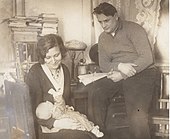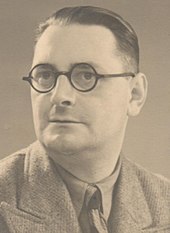Bernhard Zessin
Bernhard Zessin (born December 1, 1900 in Berlin ; † June 6, 1983 in Falkensee ) was a German communist , union official and resistance fighter against the Nazi regime.
Life
As the son of a social democratic construction and coal worker and a mother who worked as a cleaning worker and cook, Zessin grew up in poor conditions in Berlin-Moabit . He attended from 1906 to 1914, the eight-year elementary school and learned 1915-1918 in Moab Locksmith and Maschinenbauanstalt Ernst Lenz the locksmith - and tool-making trade . In order to gain further qualifications, Zessin also attended a technical college for mechanical engineering .
From an early age, Zessin was involved in social democratic youth organizations. Drafted for military service during the First World War in June 1918 , Zessin took part in the armed fighting of the November Revolution in Berlin-Charlottenburg after his return from the front . Zessin was also involved in the post-revolutionary conflicts in Berlin in 1919/20.
In early November 1918, Zessin joined the USPD . In the same year he became a member of the German Metal Workers Association (DMV), for which he took on a number of functions at regional level in the following years. From 1919 Zessin was active as a shop steward for the association. From 1922 to 1930 he took over the mandate of a delegate at the Berlin DMV General Assemblies - for almost the entire period.
The end of 1920 came Zessin with the left wing of the USPD to KPD over. At the beginning of the 1920s he was a co-founder of the KPD company cell and its "organizational head" at the Osram company in Berlin-Moabit, which employed him from 1920 to early 1924. At times he took on leading functions for the party in the KPD sub-district Berlin-Moabit. He also led a group of the Proletarian Hundreds there in the early 1920s . Zessin was also active in the Red Aid of Germany (RHD).
Zessin took part in the suppression of the Kapp Putsch in March 1920 and in militant demonstrations by the Communists in Berlin, which is why criminal proceedings were initiated against him several times.
Due to his political activities, Zessin had to change jobs several times in the early 1920s. After working for the Osram company , he worked as a locksmith at the Berliner Straßenbahn-Betriebs GmbH in Berlin-Charlottenburg from the end of March 1924 to the beginning of June 1927 . Then Zessin worked from July to November 1927 at Berlin-Anhaltische Maschinenbau AG (BAMAG-Meguin) and from December 1927 to March 1930 in the AEG plants as a fitter. He was primarily employed in the AEG workshops in Berlin-Rummelsburg . Zessin was there member of the works council and in 1930 the top candidate in the works council elections on the “red list” of the Revolutionary Trade Union Opposition (RGO). In 1929/30 he also took on other functions for the RGO. Because of his commitment to the communist RGO and because of the job cuts caused by the crisis situation, he was dismissed from the AEG in the spring of 1930.
With his partner Erna Lenz , Zessin moved to Moscow on behalf of the KPD leadership in the early summer of 1930 , where he worked for several years as a master craftsman and apprentice trainer in the lamp production of the "Elektrosawod". In Moscow he separated from his fiancée Erna Lenz, who returned to Germany in August 1931. She was arrested in 1937 and sentenced to two years imprisonment for illegal activity for the banned KPD in Berlin-Kreuzberg . In Moscow, Zessin had been married to a Russian woman since November 1931 and had a daughter.
From 1930 to 1936, Zessin was a member of the CPSU , the Soviet metal union and other organizations. After his return to Berlin at the end of 1936, Zessin was under police surveillance and had to report to the station several times a week. Nevertheless, he took part in resistance activities, among others with Rosa Lindemann , Max Riedel , Fritz Storch , Erna Lenz and Alma Kleiner . Zessin sold illegal magazines and distributed leaflets. At the same time he raised money for imprisoned communists and their families.
In addition, Zessin is said to have been involved in espionage activities for the Soviet Union at Osram . Apparently for this reason the communist had traveled illegally from Moscow to Berlin before 1936. After returning from Moscow in 1936, Zessin was arrested and interrogated several times in Berlin. House searches and assignments to selected businesses whose owners were particularly close to the National Socialists followed. In connection with arrests and interrogations, he said he was mistreated by Nazi persecutors. He married the second time in the summer of 1943, and his wife died seven weeks after the marriage in an Allied air raid in Berlin-Moabit.
For fear of imminent arrest and in order not to be drafted into military service, Zessin went to the outskirts of Berlin to Falkensee in early 1945 . He was hiding there. With other communists he organized support for “ foreign workers ” and waited for the war to end.
After the end of the Second World War , Zessin took part in the socio-political reconstruction in Falkensee in cooperation with the Soviet occupying power - also because of his knowledge of the Russian language . Above all, he got involved in the construction of the local hospital from mid-May 1945. In 1945/46 Zessin was a member and functionary of the newly founded KPD in Falkensee. From the end of April 1946 he took over several functions in the SED , including several years “political leader” of the party at local and operational level.
From the end of 1945 Zessin was a member of the FDGB local board of Falkensee and later of the Osthavelland ( Nauen ) district board . From May 1945 to March 1950 he also took over the administration of the hospital in Falkensee. From April 1950 to August 1953, Zessin worked for the state government of Brandenburg in Potsdam in the administration of the Ministry of Health and later the Ministry of the Interior. A short time afterwards he was in the service of the Potsdam District Council . From September 1953 Zessin was employed by the regional labor protection inspection of the FDGB in Nauen and Oranienburg , which he headed until retirement age.
At the end of January 1949, Zessin was married again and had a second daughter. He was recognized as "persecuted by the Nazi regime".
Honors
Zessin received several awards in the GDR . Among other things, he was the recipient of the " Medal for Participation in the Armed Struggle of the German Working Class in the Years 1918 to 1923 " (1958), the " Fritz Heckert Medal " (1963) and the " Merit Medal of the GDR " (1973) .
Literature / sources
- Sergei W. Shuravlyov: I ask for work in the Soviet Union. German skilled workers in Moscow in the 1930s . Ch. Links-Verlag, Berlin 2003, ISBN 3-86153-275-1 .
- Brandenburgisches Landeshauptarchiv , inventory Rep. 401, No. 5083, VdN file Bernhard Zessin (documents in connection with the recognition as persecuted by the Nazi regime).
- BStU archive, holdings: Potsdam branch, No. 4/53 ( MfS documents on the observation of Bernhard Zessin).
- Portrait of Bernhard Zessin . In: "Märkische Volksstimme", April 22, 1975, p. 12.
- Fritz Pose, Erich Matté, Erich Wittenberg: Berliner Proleten tell about Moscow's electric soda . Moscow 1932 (German edition).
- Stefan Heinz : Moscow's mercenaries? "The Union of Metal Workers in Berlin": Development and failure of a communist union . VSA-Verlag, Hamburg 2010, ISBN 978-3-89965-406-6 .
| personal data | |
|---|---|
| SURNAME | Zessin, Bernhard |
| ALTERNATIVE NAMES | Zessin, Bernhard Heinrich Martin |
| BRIEF DESCRIPTION | German resistance fighter |
| DATE OF BIRTH | December 1, 1900 |
| PLACE OF BIRTH | Berlin |
| DATE OF DEATH | June 6, 1983 |
| Place of death | Falkensee |




